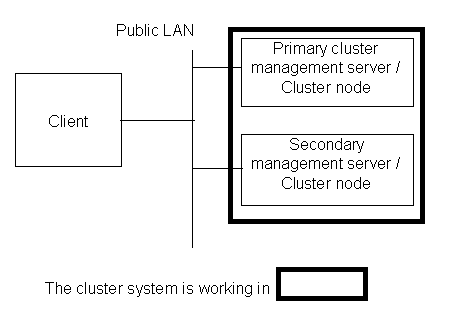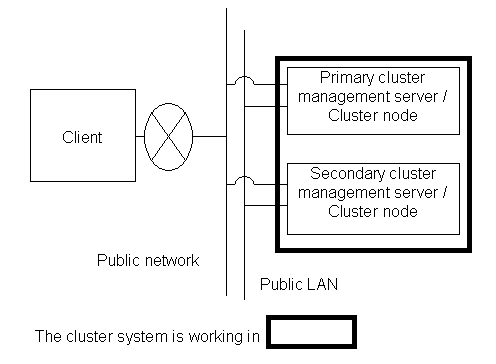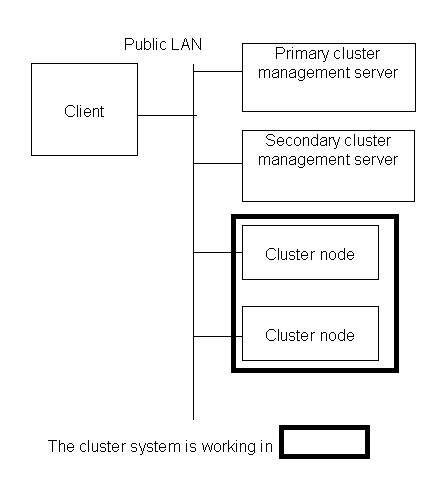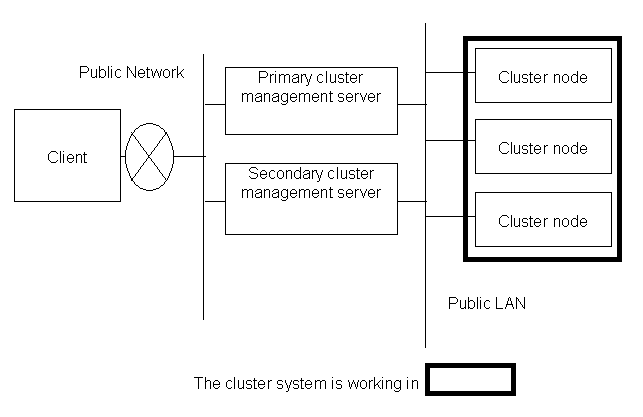

| PRIMECLUSTER Installation and Administration Guide 4.1 (for Solaris(TM) Operating System) |
Contents
Index
 
|
| Part 1 Planning | > Chapter 2 Site Preparation |
Determine the operation mode of Web-Based Admin View according to your PRIMECLUSTER configuration. Consider system performance and RC2000 that controls the OS console.
This section describes operation modes and typical models of PRIMECLUSTER systems that run Web-Based Admin View, and provides a guideline for adopting models.


When a cluster contains 3 or more nodes, the 3-tier model, in which the cluster management server is not in the cluster, is recommended.
 Roles of individual nodes
Roles of individual nodesWeb-Based Admin View adopts a logical 3-tier architecture, which consists of clients, a cluster management server, and cluster nodes. It has the following functions.
 Clients
ClientsA client is a computer with which a user manages operations. Basically, the computer is a personal computer that uses a Web browser or Solaris Workstation.
 Management server
Management serverThe cluster management server manages cluster operation and features web server functions. The server can be as a cluster node. The cluster management server can be duplexed. In this case the system will have a two-server configuration, consisting of a primary management server and a secondary management server.
Set up both primary and secondary management servers for redundancy.
You can dynamically move the secondary management server depending on the operation mode. The cluster management servers run Solaris.
 Cluster nodes
Cluster nodesCluster nodes construct the PRIMECLUSTER system. The cluster nodes run Solaris.
 Logical 3-tier architecture and operation models
Logical 3-tier architecture and operation modelsWeb-Based Admin View adopts a logical 3-tier architecture consisting of clients, management servers, and monitored nodes. Physically, the system can adopt a 2-tier architecture.
Typical operation modes that run Web-Based Admin View are introduced below.
 2-tier model
2-tier modelIn the 2-tier model, the cluster management server and the cluster node are used together on the same machine, and the client is on a machine other than the nodes and the management severs.
This model is used for a configuration where the number of nodes is relatively small.
Normally, this model is used for an operation mode such as 1:1 standby or mutual standby in a 2-node configuration.
If the RC2000 is used with this model, you need to adopt local operation.
In the local operation, RC2000 supports integrated management of the OS consoles of multiple nodes without linking to the cluster management server.

For details on the RC2000 operation mode, see the "RC2000 User's Guide."
This model supports 2 types of topology, which are described below.
 Topology where a network is shared
Topology where a network is sharedIn this topology, the public LAN and the LAN that is connected to the management client are used together. You can adopt this topology if the network users and network range are limited for security. This is the default Web-Based Admin View configuration after PRIMECLUSTER installation.

 Topology where separate LANs are used
Topology where separate LANs are usedIn this topology, the public LAN and the LAN that is connected to the management client are separate. When using a management client from a public network, this topology is recommended for security. After the PRIMECLUSTER installation is done, you will need to modify the Web-Based Admin View configuration.
Specify IP addresses used for a cluster node and a client respectively. For details, see "Setting Up CF and CIP."

 3-tier model
3-tier modelIn the 3-tier model, clients, cluster management servers, and cluster nodes are set up separately.
This model is adopted for configurations where the number of nodes is relatively large.
Normally, this model is used for integrated management of the PRIMECLUSTER system. You can also use this mode when you do not want to impose the load of running the management server on the cluster node or when you want to perform the integrated management of the PRIMECLUSTER system.
To maintain operation continuity and availability, Fujitsu recommends this 3-tire model for a configuration with 3 or more nodes.
When the RC2000 is used with this model, you need to adopt server/client operation.
In the server/client operation, RC2000 supports integrated management of the OS consoles of multiple nodes, and can be operated on the cluster management server as well as on the client.

For details on the RC2000 operation modes, see the "RC2000 User's Manual."
This model supports 2 types of topology, which are described below.
 Topology where a network is shared
Topology where a network is sharedIn this topology, the public LAN and the LAN that is connected to the management client are the same. You can adopt this topology if the network users and network range are limited for security. This is the default Web-Based Admin View configuration after PRIMECLUSTER installation.

 Topology where separate LANs are used
Topology where separate LANs are usedIn this topology, the public LAN and the LAN that is connected to the management client are separate. When using a management client from a public network, this topology is recommended for security. After PRIMECLUSTER installation is done, you will need to modify the Web-Based Admin View configuration.
Specify IP addresses used for a cluster node and a client respectively. For details, see "Setting Up CF and CIP."

Contents
Index
 
|